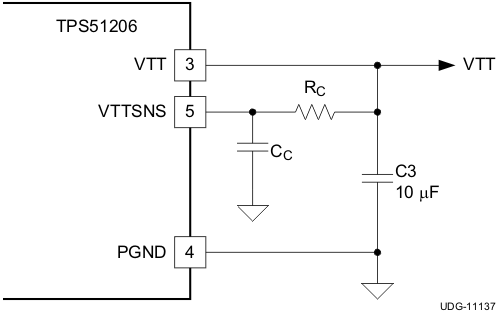SLUSAH1E MAY 2011 – July 2018 TPS51206
PRODUCTION DATA.
- 1 Features
- 2 Applications
- 3 Description
- 4 Revision History
- 5 Pin Configuration and Functions
- 6 Specifications
- 7 Detailed Description
- 8 Application and Implementation
- 9 Power Supply Recommendations
- 10Layout
- 11Device and Documentation Support
- 12Mechanical, Packaging, and Orderable Information
8.2.1.2.5 VTTSNS Connection
To achieve tight regulation with minimum effect of trace resistance, a remote sensing terminal, the VTTSNS pin should be connected to the positive terminal of the VTT pin output capacitor(s) as a separate trace from the high-current path from VTT. Consider adding a low-pass R-C filter at the VTTSNS pin in case the ESR of the VTT output capacitor(s) is larger than 2 mΩ. The R-C filter time constant should be approximately the same or slightly lower than the time constant of the VTT output capacitance and ESR.
 Figure 25. R-C Filter for VTTSNS
Figure 25. R-C Filter for VTTSNS